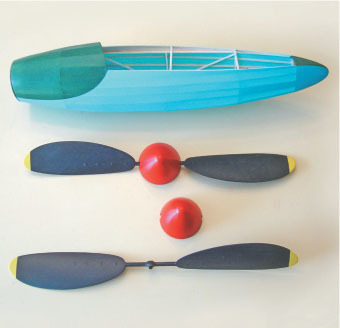Free Flight Scale
By Tom Hallman | [email protected]
As seen in the March 2023 issue of Model Aviation.
WHEN I FIRST started flying rubber-powered Free Flight (FF) in 1987, I had no idea about rubber and propeller combinations for various-size models. I relied on what the plans suggested, along with articles in model magazines and newsletters, and would often ask other fliers on the field in hopes of removing some of the mystery. Fortunately, all of my mentors were willing to share much of their knowledge and point me in the right direction.
This collection of commercial and homemade propellers for models of various sizes in the author’s fleet have a wingspan range of 13 to 54 inches.
Through experience, I have found that I’ve zeroed in on a few standard combinations that have served me well throughout the years. Generally, they’re based on the wingspans to which I’m drawn and also on the models’ weight. It’s still a heuristic approach—an educated guess rather than something heavily calculated, using algorithms and such. FF has to be relaxing and more intuitive for me if I’m to remain in that happy place. After schematics or complex theories are factored in, I tend to lose interest.
My go-to wingspans for Scale models have been 13-inch Peanuts, 16-inch Dimers, and 22-, 27-, and 36-inch Jumbos. A few have gone much larger. Those big boys are mostly on their own, but the general rules still apply to help you get closer when selecting the rubber and propeller sizes. For all of my models, I tend to go with as large of a propeller as possible then back off a tad if the model can’t handle it, although I’m never quick to make that change.
The propeller diameter has been generally consistent for the wingspans previously noted. Peanuts come in between 5.5 and 6.5 inches, while Dimers are usually 7 inches. Twenty-two-inch models will use a 9-inch propeller, and the 27-inch series of aircraft have all done well with the 10-inch white Easy Built Models propellers.
The author’s 27-inch Seafire Mk LIII soars above Wawayanda using a 10-inch Easy Built Models white propeller on the nose. Photo by Peter Kaiteris.
I really love these 10-inch propellers because they do a great job of pulling the models skyward for long runs. It’s as though the model starts in cruise mode, never getting out of sorts during the initial power burst. Note some of the videos on my MaxFliArt YouTube channel with the 27-inch Seafire or Pulqui (see the "Sources" listing). Both have a gentle pattern that keeps them aloft for a long time.
The 36-inch Jumbos usually have 11- to 12-inch propellers, while similar-size twins take as much propeller as I can fit between the nacelles and fuselage without being too close to scrape it, should the model come in for a rough landing.
For the pitch on a homemade propeller, it’s nothing scientific. I do my best to match or come close to what has worked with the plastic propellers. I check the pitch of the plastic propeller on my jig with a 30º card-stock triangle and lay on the new blade at the same angle. I might open it up a tad, but it is generally similar. This has worked very well for my Jumbo twins and the 54-inch Nicholas Beazley. I can explore making your own propellers in a future column.
Because I rarely change propellers, everything else on the model is up for tweaking through the initial trim sessions, with a focus on thrust, the center of gravity, tail surfaces, and wing warping via Gurney flaps and wingtip weight.
To determine the weight for the first rubber motor in a new model, I start at 30% to 35% of the model’s weight without rubber in it. I try to go as long as possible for lengthy motor runs, although I typically start with a completed motor that is three times the hook-to-peg length before braiding.
For most models, I try to make the motors with two loops, although there are a few airplanes that blow that approach out of the water, using motors that go beyond 50% of the model’s weight. The 17-inch MiG-15, the 27-inch Pulqui, and the Blériot pusher-canards can venture into that area. Additionally, a few have come in under the standard range, when the gain of adding rubber is minimized by the increased weight of nose ballast.
The author’s 13-inch MiG-DIS Peanut with its 37-inch big brother. Both have flown well in Muncie IN, Geneseo NY, and Wawayanda NY.
Some models can handle more rubber than others, including this 13-inch Bleriot XXVI.
One of the 37-inch MiG-DIS’s nacelles with balsa nose cones and 10.5-inch diameter propellers was made with 5/32-inch diameter bamboo spars and blades from ricotta cheese containers.
This 35.5-inch Hodel HK-101 can handle a lot of rubber with long nacelles and the 10.5-inch homemade propellers.
For 36-inch twins, the thrust from the large 10.5-inch homemade propellers has allowed me to pack the nacelles with a lot of rubber (9-inch hook-to-peg; two loops of 3/16 × 34 inch), which leads to 1,600 to 1,700 turns. That turns into 85 to 90 seconds of power, so when the model is up there, it will glide for the rest, if a 2-minute duration is your goal.
With a lot of FF activity on our favorite fields, 2022 was a good year for reconnecting with friends. Let’s all use the good wood, and spend time teaching the juniors. Dream, ponder, and build … but most of all, fly!
SOURCES:
National Free Flight Society (NFFS)
www.freeflight.org
Flying Aces Club (FAC)
www.flyingacesclub.com
MaxFliArt
Hallman Studio
www.maxfliart.com
Tom Hallman’s YouTube Channel
www.youtube.com/user/maxfliart
Easy Built Models
[email protected]
www.easybuiltmodels.com
Volaré Products
(269) 339-9795
www.volareproducts.com













Comments
Add new comment